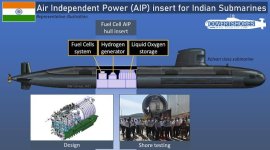Navigation
Install the app
How to install the app on iOS
Follow along with the video below to see how to install our site as a web app on your home screen.
Note: This feature may not be available in some browsers.
More options
Style variation
You are using an out of date browser. It may not display this or other websites correctly.
You should upgrade or use an alternative browser.
You should upgrade or use an alternative browser.
The 10 Best Diesel Electric Submarines In 2023
- Thread starter ety
- Start date
DRDO’s AIP system relies on the innovative Phosphoric Acid Fuel Cell (PAFC) technology. This process is more rugged, tolerant of fuel impurities, offers longer life and efficiency, and is much safer since it does not require hazardous hydrogen to be stored onboard.
While based on a proven fuel cell technology type, i.e., PAFC, NMRL’s AIP system, nonetheless, incorporates a set of innovations that make it a rather contemporary system. For one, NMRL’s AIP package has an onboard hydrogen generation plant, which produces hydrogen ‘in situ,’ unlike many other AIP configurations where hydrogen for a mission has to be carried onboard.
Moreover, onboard hydrogen production in NMRL’s/DRDO's AIP does not require any kind of combustion. NMRL’s AIP supplies hydrogen ‘in situ’ by reacting hydrogen ‘rich’ sodium borohydride, which is carried onboard, with water, to generate hydrogen and sodium metaborate. The advantages of this kind of ‘borohydride hydrolysis’ (BH) to generate hydrogen vis-a-vis other forms of onboard hydrogen generation. NMRL’s/DRDO's BH process generates a considerable amount of hydrogen without entailing the release of any gaseous effluents which add to system noise and can compromise submarine stealth. Moreover, BH plants also have long operational lives.
What NMRL/DRDO has done is further develop basic PAFC-related know-how to come up with indigenous PAFC stacks that are ruggedized and compact enough to be suitable for underwater marine applications with the relevant safety margins. NMRL has registered a number of innovation patents on its way to the development of indigenous PAFC stacks related to the catalysts used, sealants, acid holder matrix, carbon paper, etc.


While based on a proven fuel cell technology type, i.e., PAFC, NMRL’s AIP system, nonetheless, incorporates a set of innovations that make it a rather contemporary system. For one, NMRL’s AIP package has an onboard hydrogen generation plant, which produces hydrogen ‘in situ,’ unlike many other AIP configurations where hydrogen for a mission has to be carried onboard.
Moreover, onboard hydrogen production in NMRL’s/DRDO's AIP does not require any kind of combustion. NMRL’s AIP supplies hydrogen ‘in situ’ by reacting hydrogen ‘rich’ sodium borohydride, which is carried onboard, with water, to generate hydrogen and sodium metaborate. The advantages of this kind of ‘borohydride hydrolysis’ (BH) to generate hydrogen vis-a-vis other forms of onboard hydrogen generation. NMRL’s/DRDO's BH process generates a considerable amount of hydrogen without entailing the release of any gaseous effluents which add to system noise and can compromise submarine stealth. Moreover, BH plants also have long operational lives.
What NMRL/DRDO has done is further develop basic PAFC-related know-how to come up with indigenous PAFC stacks that are ruggedized and compact enough to be suitable for underwater marine applications with the relevant safety margins. NMRL has registered a number of innovation patents on its way to the development of indigenous PAFC stacks related to the catalysts used, sealants, acid holder matrix, carbon paper, etc.


Users who are viewing this thread
Total: 1 (members: 0, guests: 1)
Country Watch Latest
Latest Posts
-
-
Hezbollah-Israel Conflict 2024 - Lebanon & Occupied Palestine Territories (32 Viewers)
- Latest: Falcon29
-
-
-


